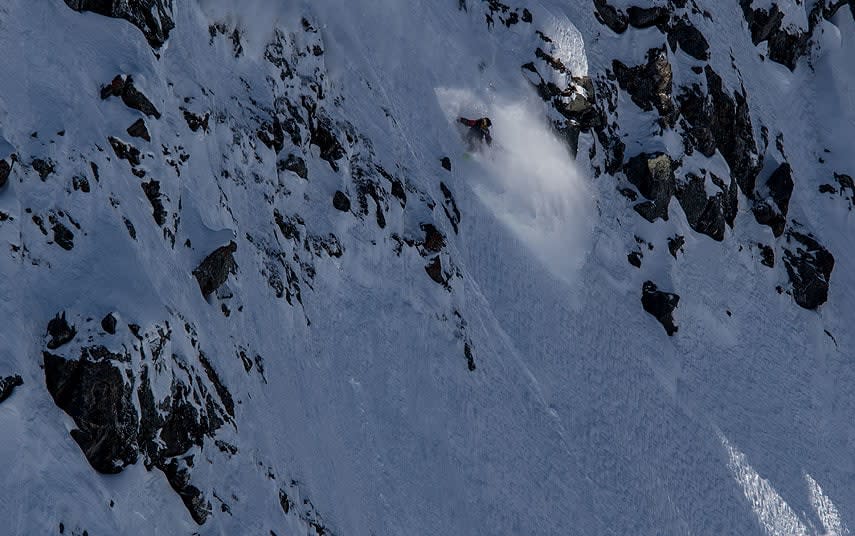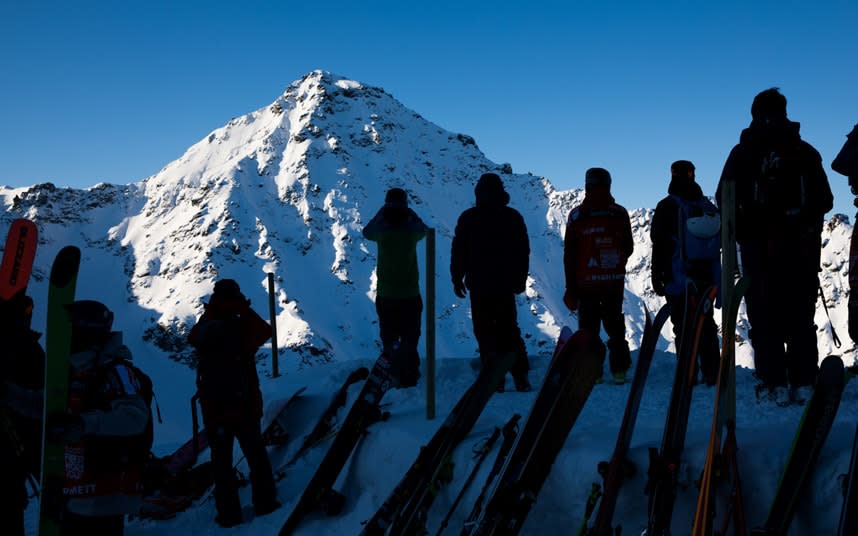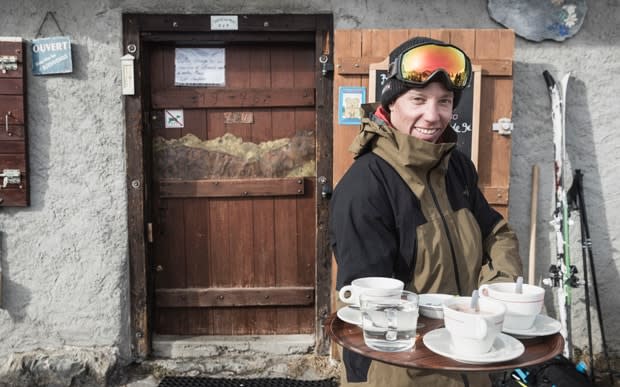Sam Anthamatten: Inside the head of a pro freeride skier

It takes a special kind of person to be comfortable skiing or snowboarding the intimidatingly steep mountain venues used for freeride skiing and snowboarding contests. The pros (obviously) have nerves of steel and the skills to match – but do they have to have a few screws loose to hit slopes like these? We caught up with Sam Anthamatten at the season final of the annual globe-trotting Freeride World Tour to find out.
20 epic photos from the Freeride World Tour
From Zermatt in Switzerland, Anthamatten is among the world’s top big mountain skiers, making regular appearances on the Tour. This year’s final, which takes place every year on the scary verticals of the Bec des Rosses in Verbier, Switzerland, didn’t go to plan – he crashed during a 360 spin off the side of a cliff – but in 2011 he won a leg of the five-event tour and came second overall. He’s also a regular in Timeline Mission movies with fellow pros like snowboarder Xavier De Le Rue, as well as a ski instructor, pro climber and mountain guide, with first ascents and descents to his name from Switzerland to Patagonia.
How do you assess a slope before a Freeride World Tour event?
There’s a gentlemen’s agreement we don’t ski the face for one month before an event, and conditions change a lot in that time. But local guides take on the risk management, and while you’re never free from risk, that way we can focus on the competition. On inspection day, shortly before the comp, we can look at the face from different angles – using binoculars and taking photos from the base – but not ride it. If you look at a face for hours, you can put a plan together.

How do you decide your line in a contest?
As well as good snow, I’m looking for a line that’s special and suits my strengths. On the day, we have to walk to the start area, so we can see the face close up. But by then I have a plan ready, sometimes two – one that’s fast but with smaller jumps and a more technical one with bigger jumps. Sometimes you wake feeling powerful, sometimes tired, so you have to be able to adapt.
Do you use different skis depending what you're doing, or always use the same ones?
Actually I ski a lot of different skis, because for every line I'm doing, or conditions we have, there are skis I prefer. My ski sponsor is Faction and in Verbier I was on the Dictator 186, but at the beginning of a season, when I can be more playful, I ski more on the Candide, or on the Prodigy. The Dictator is much stiffer and way more line driven – less turny – than the Prodigy. For big mountain riding you can just put it down and it cruises through everything – ice or spring snow, powder. In my opinion it’s the perfect competition ski, but for a normal person I don’t think it’s easy to ski.
What safety kit do you use?
All FWT riders have to wear transceiver, back protector, helmet and an avalanche airbag backpack with shovel and probe. Even with the risk management, it’s possible an avalanche can happen during an event. If you think about it, even a pocket of four metres square is a lot of snow. Not enough to bury you, but you can still be carried away by sluff.
How an airbag could save your life in an avalanche
I always have transceiver, shovel and probe, even if I’m planning to be on piste, because you never know where you might end up – I want to be ready. I always wear a back protector and crash pants too, as well as a helmet, even on piste – there are more people around so it’s harder to manage the risk. I almost never wear a helmet when hiking – you sweat a lot. But if it’s really exposed or a rocky gully, you ought to.
I heard your motto is “steep, deep and crazy”?
Yes, why not! But it’s not me that’s crazy, it’s the lines. In the movies you see two minutes of action, but you don’t see any of the preparation. They say we’re crazy, maybe that fits the sport. But there’s not as much risk as people may think. I reckon Formula One drivers take more risks.
How do you develop your skiing?
It’s from the feedback I have from my friends, and it’s more like a game, one guy picks something and everyone has to do it in the way he’s doing it. I think every day my skiing should progress, that’s the goal, to learn more, to change, to be the most complete skier, not only like being the best big mountain skier. I want to train my freestyle skills – if you have the opportunity to make a 360 on a cliff and land it, it’s way better than a normal jump.
How do you prepare when it’s not a contest?
I'm planning a first descent of Mount Ushba in Georgia in May/June this year and that has taken half a year to prepare. But there’s a lot to think about even the day before any trip. You check the weather and the temperature to assess potential avalanche danger. Then the next day, out in the field, if conditions are still the same, you adjust plans accordingly.
I prepare all my kit the night before. I’m very precise – it feels good to trust that in one quick movement you’ll have an ice axe in your hand when it’s needed. It’s not about being able to take more risks, it’s about being prepared for whatever happens. I need to sleep well too. If you don’t sleep well because of a bad feeling in your stomach, it’s time to change your plans.
What does it feel like to ski a really steep off-piste descent? Is it fun?
Of course it’s fun. But when you’re on a really technical, steep face, you’re not thinking about how much fun you’re having, you have to stay really focused. You have to be precise and ski well and not make any mistakes – but it’s really all in the mind. When you successfully get down, that’s when it feels amazing.
What’s the attraction of doing a first descent? Does it scare you?
The thing is, you don’t do it for the recognition of being the first. The appeal is that no one has been there before you, there’s no information about it, you don’t even know if it’s possible. It’s not, “Hey, we can do this, let’s go.” You have to make every decision yourself, it’s much more focused on that process. The feeling isn’t fear, it’s more respect.
I started skiing very young, and I’ve spent a lot of time on the slopes, teaching and as a mountain guide as well. After a while skiing on normal slopes, you look elsewhere for something special. Your exposure to risk increases but you get a lot back – mental and physical challenges. Although it is possible to find something special in the Alps, a great part of this job is that we can travel.
What should holiday skiers and snowboarders think about before going off piste?
If taking a guide, you don’t have to worry about risk management yourself. Anyone going on their own needs to keep the risk as low as possible. Wear a transceiver, check the weather and avalanche risk and don’t go into the unknown. A few years ago I was skiing a really cool couloir in Zermatt. There were a couple of people in front of us, and it turned out they didn’t know it ended with a cliff. One fell down the cliff, another one ended up in a tree.
Of course, even when going with a guide, people should take some responsibility for themselves. Anything could happen. Everything you know helps keep the risk down. Even a little knowledge is worthwhile – to understand you don’t know enough is good. After my mountain guide education, I have a good base to assess risk. But you never finish learning.
How often do you decide not to ski a slope you had already planned to?
You might decide to call it off at any point. I’ve made that decision so many times I can’t remember. You need to have the strength to walk away. To say yes is easy, no is much harder. Once I was out with my older brother, Simon, I was maybe 13. We wanted to do a slope, and Simon said we’ll do another, easier one first, then we’ll see. When we looked up at the slope we wanted to do from the bottom, we saw a guy on it in an avalanche. I learnt from that. Trusting your instinct and knowing when to say no keeps you alive longer. The same will apply in Georgia – if it’s no it’s no, not maybe. We have from mid-May to mid-June for the first descent, so there should be enough time. But there’s a lot of waiting, and as time goes on, the pressure mounts.

Is knowledge power?
It’s a kind of power. But after a while you get experience, from seeing a lot of things. Not all are great – sometimes you see nature is much bigger than you, it makes you scared. I have lost friends mountain climbing and ice climbing. It’s usually down to a stupid accident when you’re not even in a difficult place. A loss of concentration, a little mistake. Even on the easy slopes you have to stay focused. That’s when you relax, so that’s when you need to take extra care.
What’s the most important piece of safety kit?
I read something, “they had the best piece of safety equipment with them, but they didn’t use it. Their brain.” I would agree, to use your brain is the most important.
For more on the Timeline Missions visit timelinemissions.com, and for more about the Freeride World Tour, and to watch video footage from the events, visit freerideworldtour.com.

